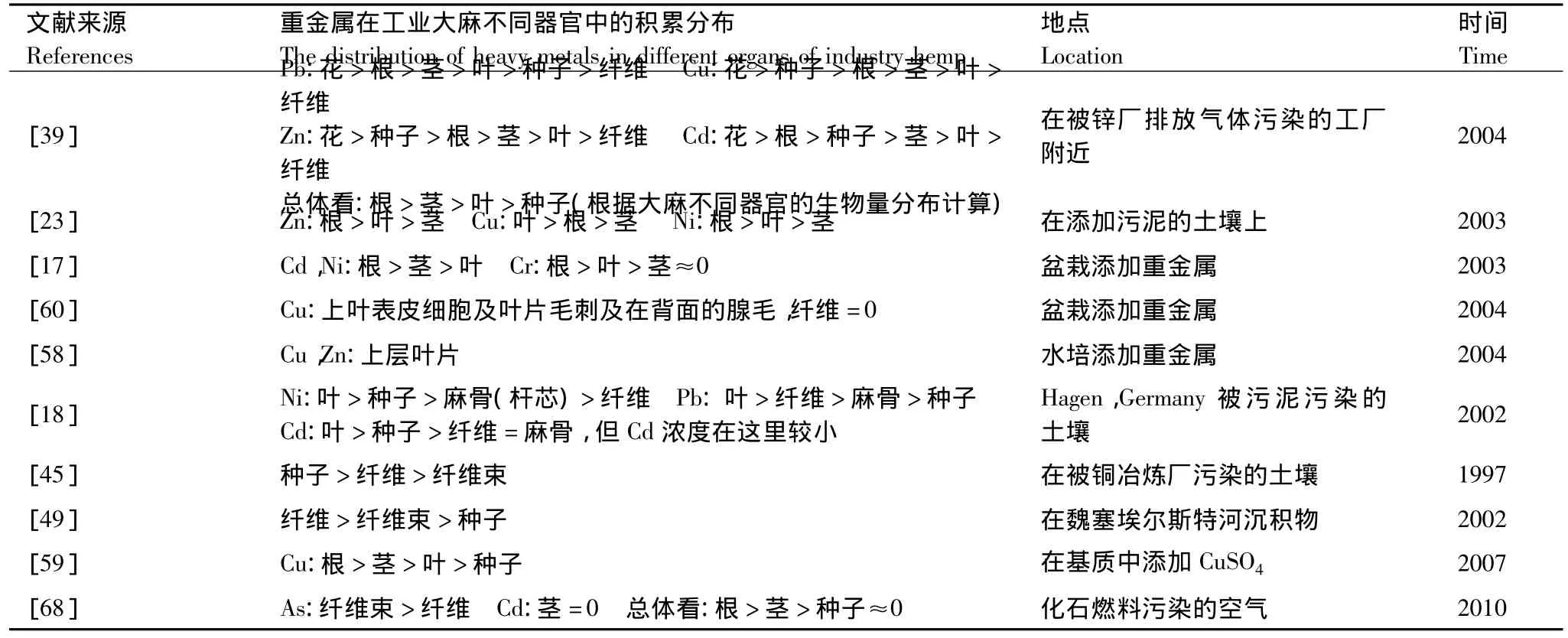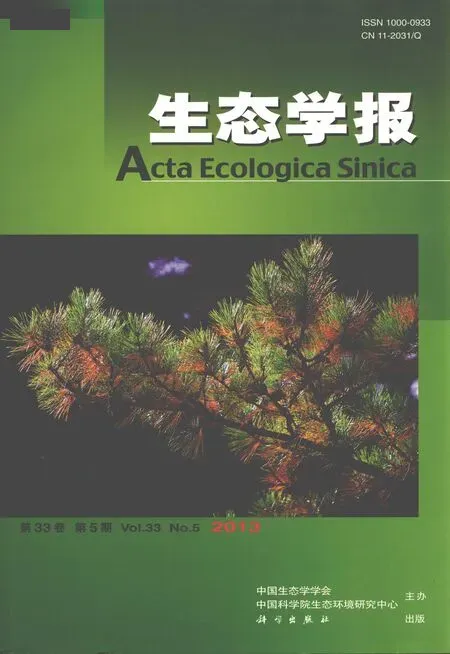工业大麻对重金属污染土壤的治理研究进展
梁淑敏,许艳萍,陈裕,杨 明,郭鸿彦
云南省农业科学院经济作物研究所,昆明 650205
土壤是人类赖以生存和发展的物质基础,是农业生产的基本生产资料。但随着我国工业化的不断深入,多种含重金属的污染物通过各种途径进入土壤,造成了土壤的重金属污染,从而导致土壤退化,并通过食物链危及人类健康和生命。如何减轻日益严重的重金属对土壤污染,进而修复还原利用的问题已迫在眉睫,亟待研究。目前,有几个清洁污染土壤的方法[1-2],其中最理想的是植物修复技术[3-10]。植物修复技术是指利用植物吸收、提取、分解、转化或固定等作用将土壤、沉积物、污泥、地表或地下水中的有毒有害物质去除或降低其毒性的技术总称[11]。相对于其他的常规治理方法,植物修复以其廉价、清洁、不破坏环境、不会造成二次污染等优良特性已日益引起了学术界和政府部门的广泛重视。
植物修复的前提是找到对某种或某些重金属具有特殊吸收富集能力的植物种或基因型,即重金属的“超富集植物”[12]。一直以来,人们比较关注超富集植物的筛选,并取得了一定的进展。但至今人们所发现的自然界中的超富集植物大多为野生型植物,生物量低、生长缓慢、植株矮小,因而限制了其对污染土壤重金属的移除效率,也不利于大面积的机械化操作,造成实际应用性差[13-14]。另外,这些自然界的超富集植物对生物气候条件要求较严格,区域性分布强,严格的适生性使成功引种受到限制,严重制约了其大规模的应用[14]。所以国内外专家不再局限于寻找超富集植物,而把目光转移到对重金属具有耐性,适应性强、分布广泛和生物量高的栽培作物[10,15],如大麻(Cannabis sativa L)、芥菜(Brassica juncea(Linnaeus)Czernajew)、亚麻(Linum usitatissimum)、玉米(Zea mays L)、大麦(Hordeum vulgare L)等农作物,这些作物与超富集植物相比体内重金属含量很低,但因植物生物量及生长速度都远远大于超富集植物,即便体内重金属含量未达到临界含量标准,同样时间内所积累的重金属绝对量反而比超富集植物积累的绝对量大,对重金属污染土壤的修复作用更大[13]。国外许多研究表明,工业大麻对重金属有较强的耐性和富集能力[16-19],相反,国内在这方面研究还很有限。因此有必要对工业大麻修复重金属污染技术进行深入研究和总结,扩大其应用范围,以便为工业大麻对重金属污染的治理研究及耐重金属或超富集工业大麻品种的选育和栽培技术研究提供指导。
1 工业大麻是一种修复重金属污染土壤的优良作物
大麻是大麻科大麻属1年生草本植物,工业大麻(本文出现的大麻一词皆指工业大麻)属于四氢大麻酚含量低于0.3%的符合各国法律规定的含量标准的,且已无毒品利用价值的大麻品种。它的优良特性有:栽培历史悠久、分布广泛、生物量大、抗逆性强、生长速度快、生育期短、根系庞大、碳汇能力强、易种植管理、耐密植和易于机械化操作,并且具有多种工业用途及广泛的应用前景[20]。最早应用工业大麻去除重金属污染物的是1998年The Phytotech公司,该公司利用种植大麻去除切尔诺贝利核电站的污染物,其治理结果显著[21]。同时1999年Saint Louis推荐说工业大麻地上部分具有积累放射性U和Pb的作用[22]。诸多优良特性,使得越来越多的国内外学者把工业大麻作为理想的植物修复候选作物。
1.1 工业大麻修复重金属土壤的年限
在重金属污染的土壤上通过几次(几年)种植大麻,重金属在土壤中的浓度将降低到满意的(限定)水平[23]。而在相同的条件下,利用其它植物修复需要15a甚至更长时间才能清除土壤重金属类污染[24]。但对于一些特殊的重金属污染土壤,大麻也需较长的年限才能修复土壤。如将土壤中Pb浓度从1100mg/kg降至300mg/kg(86/278/EEC限定),需要种植工业大麻约10—15a[25]。被某些重金属污染的土壤可能要100—200a时间才能恢复[26]。
1.2 工业大麻修复重金属土壤的费用
比较植物修复费用与常规治理费用,植物修复费用要远低于常规治理。据美国实践,种植管理费用在每200—10000美元/hm2之间,即每年每1m3的处理费用为0.02—1.00美元,比物理化学处理的费用低几个数量级[3]。由于高昂的修复费用,相对应美国对有毒废物污染场所的生物修复项目费由1994年的2亿美元提高到2000年的28亿美元,6a内增长达14倍之多[27]。由此可预见,大麻修复重金属土壤的费用可能较低。
1.3 工业大麻修复重金属土壤可产生的经济效益
经研究表明:种植在Zn污染土壤上的大麻,其种子可以加工为生物柴油,生物柴油已被认为是替代石化燃料、惠及农业生产的最佳选择[28-29],同时其修复重金属土壤时生产的大量生物质在冶金回收上能产生可观的经济效益,由于我国研究大麻修复重金属土壤刚起步,相应的经济效益比较研究也较少,但通过参考其他的超富集植物,可以预见大麻修复重金属土壤的经济效益很可观。如Nicks等[30]研究认为,通过超富集植物回收重金属Ni产生的直接经济价值为539美元/hm2。如果采用焚烧法,植物生物质燃烧产生的25%热能能够得到回收利用,便可以产生额外的利润219美元/hm2。这就是说通过植物修复能产生的总经济效益为758美元/hm2,若总经济效益减去整个过程所耗费用,净利润为379美元/hm2,而种植小麦的净利润仅为309美元/hm2。因此,种植超富集植物比种植小麦的经济价值还要高70美元/hm2[31]。
另外,工业大麻不仅是一种修复重金属污染土壤的优良作物,而且是另一种常用材料,可利用其有效地去除或改变自然界中或者污染水域中的Cr3+,Cu2+,Ag+,Cd2+,Pb2+的存在形态[32-35],被用于治理澳大利亚的灰水,其纤维被罗马尼亚的亚西用来去除废水中的二价锌离子。在我国,2009年连惠山等研究表明,工业大麻杆芯对亚甲基蓝染料有较好的吸收和去除功能,其作为染料废水吸收剂具有良好的开发应用前景[36]。
2 重金属对工业大麻的影响及其在大麻不同部位的分布
虽然大麻对重金属有较强的耐性,但把大麻种植在重金属污染的土壤中时,不仅要考虑大麻对土壤的修复,还要考虑重金属对工业大麻的影响以及在大麻不同部位的分布。这样才能更好利用其修复重金属污染的土壤,同时能对收获后的大麻产品做后续的处理。
2.1 重金属对工业大麻生长发育和产量的影响
(1)对大麻生长发育和产量有利
当在土壤中施入浓度小于25mg/kg的Cd,在某种程度上对大麻生长有一定促进作用[28];在土壤中施入浓度小于200mg/kg的Zn也有类似的促进作用,不同的是促进了大麻的根系生长。当研究者利用西欧河道的钙质疏浚泥沙派生的表层土壤做土壤基质,发现大麻生长良好,单株生物干重为10g/株[19]。这些研究者还在土壤中添加低剂量的含重金属污泥,发现大麻的株高和干物重显著增加,但大剂量的添加污泥对大麻的株高和干物重没有显著影响[23,37-38]。因此认为,大麻是一个适宜在重金属污染土壤生长的植物,能适应不同的气候条件,可生产出品质优良的非食品产品[17]。
(2)对大麻生长发育和产量无影响
当Cd,Ni和Cr的含量分别在82,115,139 μg/g时大麻的生长和形态没有显著改变,表现为根长和分枝长及地上部分干重和根干重与对照差异不显著[17]。若人为增加重金属浓度导致大麻吸收重金属量增加,但无明显减产或收获产品质量降低[39]。因此认为,种植在重金属污染土壤中,大麻生长受影响很小[40],低浓度重金属不对大麻产生影响[18],也不影响其发育[41],其茎和种子的产量未受到较大影响[42-48]。
(3)对大麻生长发育和产量有害
在魏塞埃尔斯特河,一些研究者把大麻种植在重金属含量超标的河床沉积污泥上,尽管大麻可以完全正常的发芽,但播种后1周的大麻叶片部分变色、变形和干枯,最终约95%的植株死亡。而幸存的大麻分枝短,比未受污染的土壤上生产低得多的生物量[49]。另有一些研究者对盆栽和水培大麻进行研究,与对照相比,含重金属的基质中,植株矮小、叶片枯萎,生物量下降,高死亡率和生育迟缓,抑制大麻生长的原因是低pH和多个可移动有毒金属的协同作用[49]。还有一些研究者把大麻种植在Zn、Cu、Ni污染的土壤上,发现随着重金属的浓度增加生物量下降及根干重降低[23,50]。因此认为,大麻是一个不适宜在重金属污染土壤生长的植物[35],但可通过水杨酸预处理缓解高浓度Cd对大麻幼苗的毒害[28]。
经统计,现有84.2%研究表明重金属对大麻生长发育和产量有利或无影响,仅15.8%的研究表明重金属对大麻生长和产量有害。这说明大部分研究者认为大麻对重金属的耐受性很强,仅少部分研究者表明大麻耐受性差。经分析出现这样研究结果的原因可能是:低浓度的重金属(10-10—10-3mol/L)对大麻的生长和产量有促进作用或影响不显著,高浓度(10-1—10-2mol/L)对大麻生长会产生抑制作用或致命[51],但不排除土壤的吸收能力、土壤的pH值、氧化还原条件、有机质、土壤的质地及土壤通透性等物理性状的影响[52]。
另外,当浓度特别高的条件下,重金属还对大麻的叶、叶绿素及光合能力产生影响;对大麻纤维品质和根无影响,但能吸收比在未受污染土壤高得多的重金属(尤其是Zn、Cd和Ni)[18]。虽然对大麻生长及产量没有显著影响,但大麻植株体内的植物络合素和DNA数量增加[17]。在重金属Ni2+、Cd2+和Cr6+诱导下大麻DNA的甲基化发生改变,且5-methylcytosine(胞核嘧啶,5mC)浓度下降20%—40%[53]。
2.2 重金属对工业大麻性别的影响
大麻是雌雄异株作物,雌雄株比例接近1∶1,由于雌雄株成熟期不一致,造成生产上操作困难,管理不一致,并且雌雄株的产品不同。大麻栽培和育种研究的目的是力争收获雌麻种子和雄麻纤维(纤维雄麻品质和产量最好),以收获麻籽为主的希望雌株比例高,以收获纤维为主的希望雄株为主,而现实收获时由于雄麻占近半的比例,无形中就造成麻籽产量不高,而收获纤维雌麻纤维还未成熟。因重金属对工业大麻性别影响存在差异性特点,所以在重金属污染的土壤种植大麻根据生产需要就要考虑这方面的影响。
研究者发现,重金属盐通过改变大麻植物荷尔蒙平衡赤霉素和玉米素的比例来影响大麻的性别表达[51],赤霉素与大麻雄性表达有关而细胞分裂素与大麻雌性表达有关,植物激素和遗传共同作用从而决定了植株的性别表达[54-55]。
(1)Cu和Zn盐提高了植物的玉米素水平,使大麻雌性化,其机理是由于缺Zn导致含氮化合物的水溶性非蛋白氮的积累:酰胺和氨基酸。许多研究表明,缺Zn会抑制RNA合成,从而影响蛋白质的合成[51]。
(2)Pb(NO3)2降低了玉米素水平和增加了赤霉素水平,导致大麻明显雄性化。其机理是Pb元素使许多酶失活,其与高含硫配体的亲和力紧密相连。当Pb渗透进入细胞,它与巯基反应导致酶失活。在细胞表面或细胞内,Pb2+可以与功能蛋白质,核酸,多糖,和其他化合物反应和取代与许多功能团结合的其他金属离子,致使细胞代谢受到各种干扰。同时,在Pb的影响下摄取减少,导致硝酸还原酶活性的降低和干扰植物氮代谢。由于减少了玉米素前体的形成,玉米素含量也减少,因此,性别表达转移[51]。
2.3 重金属对工业大麻中四氢大麻酚含量的影响
工业大麻种植在重金属污染土壤保持较低的四氢大麻酚含量水平,这是大麻修复污染土壤的一个先决条件。如Sandra等研究表明土壤中Cd、Ni和Cr的含量分别在82,115,139 μg/g以下时,工业大麻的四氢大麻酚含量水平均在欧盟的毒品管制标准(干物质0.2%)之下[17]。但目前,不同气候条件及土壤质地的重金属土壤对大麻中四氢大麻酚含量影响的研究还很缺乏,有待进一步深入探讨。
2.4 重金属在工业大麻中不同部位的分布
研究重金属在大麻器官中的分布,对收获后大麻产品的后续处理至关重要。根据相关研究,各类重金属在大麻不同器官的分布存在明显差异。由表1可以看出,这些研究结论也不是完全一致的,不同的研究也有所不同,有的甚至完全相反[45,49]。据统计80%的研究表明,最大浓度的重金属积累在大麻的根和叶中,部分重金属积累在大麻的次要部位(末梢部位)。50%的研究表明纤维中含量很少或不含,种子中的含量存在分歧。另外某些元素如Cu最大的积累部分也存在分歧[28,58,59]。统计现有的研究,得到了大麻不同部位的重金属的分布:
(1)重金属在大麻根中的分布 大部分的Zn、Ni、Cr、Cu和Cd积累在大麻根部[28,39,59]。而且过量的肥料或除草剂,也可以被吸收至大麻根部[60]。
(2)重金属在大麻叶中的分布 Cu最大量的累积在大麻叶片中[58,60],在冶金企业地区,Pb仍然附着在叶片表面,而Zn、Cu和Cd可部分渗透到叶片[61]。
(3)重金属在纤维中的分布 纤维似乎不受Cu污染的影响。
(4)重金属在种子中的分布 重金属积累在种子中比纤维中多[39,46]。这与Spaite等和Schubert的研究结果相符,他们认为土壤中甚至很低浓度的Cd都积累在种子中[39,62]。Kamishentzev的研究认为Pb,Zn没有积累在种子中[39]。
(5)重金属在大麻雄花中的分布 重金属在大麻花中的含量超过地上及地下器官。这可以解释为持续时间较长的花期,使气溶胶(悬浮微粒)吸收重金属在大麻花中[39]。
重金属在大麻不同部位之所以有这样的分布,是与植物吸收重金属的机制有关。根据研究,植物吸收重金属不仅通过根,而且还通过叶[63]。在冶金企业地区,环境污染对种植作物产生了复杂的影响。如植物根从土壤中吸收重金属,而植物叶片吸收粘在其表面的气溶胶污染物。另外,诸多研究还明确证实重金属的吸收和分布明显存在不同的基因型[64-66]。一个有趣的发现是,这些基因型差异仅限于Cd,并不是库源转运微量元素的普遍现象,例如,必需金属Zn和Cu[67]。

表1 重金属在工业大麻不同器官中的积累分布研究进展Table 1 A review of the distribution of heavy metals in different organs of industry hemp
3 工业大麻对重金属的吸收能力
据研究,影响植物移除重金属的量由年生物量和重金属在生物质中的含量决定,因此生物量的大小对于植物修复至关重要。生物量越大,大麻移除的重金属越多[69]。研究者筛选14种农作物[15]和10种能源作物[70],并比较了不同轮作体系,包括(玉米-冬小麦)和(冬豌豆-冬小麦-冬大麦-大麻-冬小麦)两套轮作体系[71]。发现年平均大麻的干物质产量是11.2t/hm2,并通过根系从土壤中去除相当量的重金属[71-72],结果其吸收的Pb、Cd、Cu和 Zn最高[71],同时很少使用农药[70]。所以大麻是最有效的清洁土壤重金属的修复作物[15],其去除重金属的能力很强。
3.1 自然状态下工业大麻对不同重金属吸收能力
现有的研究表明,工业大麻主要通过植物化学合成和植物提取过程来实现对重金属的吸收[39,73],其对Pb、Zn、Cu、Ni、Cd 等有不同程度的吸收[19,25,74],并且可以减少铜矿开采和加工地区的土壤 Cu、Zn、Cd 和 Pb 含量[39]。大麻对重金属Cd、Cr和Ni的富集能力和超富集植株相比低100倍,其超高的生物量对Cd、Cr和Ni吸收也是相当可观,甚至比同样面积的超富集植株还要多[17]。此外,大麻还具有修复有机化合物(多环芳烃、蒽和苯并[a]芘)污染土壤的能力[23,75]。
由上述可知工业大麻对多种重金属都有一定的吸收能力,但不同的研究对大麻吸收不同重金属能力的结果不一致,甚至是截然相反的。2005年,Linger等研究了大麻对Ni、Pb、Cd的吸收能力,认为大麻具有很强的和积累高浓度的重金属[92]。虽然这方面的研究还有待深入,但其却有相当大的植物修复潜力,除了大麻的高生物量,它也被证明有能力将铜从根转移到地上部分,属于积累机制,这达到了一条植物修复必须满足的标准[60]。
(3)目前还没有很好的方法处理和处置这些高重金属含量的生物质[17,93]当前的主流处理方法包括:焚烧法(焚烧发电法和焚烧利用底灰回收重金属)[94]和固体压缩填埋法[11],但这些方法存在二次污染的可能,因此今后的处置方向应向非食品工业,如纺织、纸浆和造纸、建筑和家具,生物柴油及化学工业等产业发展,对其进行深加工。由于大麻在污染土壤、空气或水体中生长所生产的种子和纤维,大部分都超出了The WHO和FAO/WHO及MPC的限量[95],所以取消了大麻种子或叶用于食品生产的资格。但大麻油可用于油漆或工业用油生产。同时纤维中重金属含量超过了Öko-Tex-Initiative(Hohenstein)的限定[96],不能用作服装生产,但可用来做高级复合材料等。目前,虽然这两种办法可以被使用,但无形中在一些工业产品中增加了重金属,因此期待更进一步的深入研究来处理这些高金属含量的生物质。
(4)大麻的解毒机制还不明确。有研究表明,植物液泡是有机酸的一个主要储存位置[97],金属和有机酸的相关性是涉及液泡的金属解毒机制[98]。在Laura等的研究中,Cu也被发现存在于叶绿体内部结构,这导致了,可能不存在一个大麻金属解毒策略[60]。但也有研究表明,与对照相比,工业大麻根和茎产生的谷胱甘肽(GSH)和PC2要多,此外在重金属胁迫下,根中会产生一种新的植物络合素(PC3)[17],植株能产生高浓度的谷胱甘肽(GSH)和植物络合素(PCs)是植物耐受重金属胁迫的证据[99],利用其保护对重金属敏感的酶。因此,目前对大麻的解毒机制还存在分歧,没有一个明确的认识[10],有待进一步深入研究。
总之,目前,国外对工业大麻修复重金属污染土壤进行了诸多研究,而我国在这方面研究仅处于探索阶段。但随着各方面研究和实践的深入,以及科学技术的飞速发展,工业大麻修复重金属治理土壤污染新思路将逐步引起更多人关注,从而更好的结合对工业大麻收获产品的处理加工,达到既为农民增加一定的收入,又妥善处理污染物,避免产生二次污染效果,实现双赢目标,继而产生良好的经济、生态和社会效益。另外还可以应用现代分子生物学手段进行相关基因的分离与分子克隆,将筛选、培育出的超富集植物和微生物基因导入到大麻的植株体中,从而产生适合人们需求的高富集重金属转基因植物。可以预见,在不久的未来,工业大麻将在重金属污染土壤修复中发挥其巨大的作用,为我国的环境治理和保护工作以及农民增收带来新的希望。
[1] Rulkens W H,Tichy R,Grotenhuis J T C.Remediation of polluted soil and sediment:perspectives and failures.Water Sci.Technol,1998,37(8):27-35.
[2] Chen H M,Zheng C R,Shen Z G.Chemical methods and phytoremediation of soil contaminated with heavy metals.Chemosphere,2000,41(1/2),229-234.
[3] Cunningham S D,Berti W R,Huang J W.Phytoremediation of contaminated soils.Trend in biotechnology,1995,13(9):393-397.
[4] Cunningham S D,Ow D W.Promises and prospects of phytoremediation.Plant Physiology,1996,110(3):715-719.
[5] Ernst W H O,Bioavailability of heavy metals and decontamination of soils by plants.Geochemistry,1996,11(1/2):163-167.
[6] Chaney R L,Malik M,Li Y M,Brown S L,Brewer E P,Angle J S,Baker A J M.Phytoremediation of soil metals.Current Opinion in Biotechnology,1997,8(3),279-284.
[7] Raskin I,Smith R D,Salt D E.Phytoremediation of metals:using plants to remove pollutants from environment.Current Opinion in Biotechnology,1997,8(2),221-226.
[8] Salt D E,Smith R D,Raskin I.Phytoremediation.Annu Rev Plant Physiol Plant Mol Biol.1998,49(6):643-668.
[9] Meagher R B.Phytoremediation of toxic elemental and organic pollutants.Curr.Opin.Plant Biol,2000,3(2):153-162.
[10] Wei C Y,Chen T B.Hyperaccumulators and phytoremediation of heavy metal contaminated soil:a review of studies in China and abroad.Acta Ecologica Sinica,2001,21(7):1196-1203.
[11] Salt D E,Blaylock M,Kumar N P B A,Dushenkov V,Ensley B D,Chet I,Raskin I.Phytoremediation:a novel strategy for the removal of toxic metals from the environment using plants.Nature Biotechnology,1995,13(5):468-474
[12] Wang Q R,Cui Y S,Dong Y T.Phytoremediation—An effective approach of heavy metal cleanup from contaminated soil.Acta Ecologica Sinica,2001,21(2):326-331.
[13] Yang Y,Wang W,Jiang R F,Li H F.Comparison of phytoextraction efficiency of Cd with the hyperaccumulator Thlaspi caerulescens and three high biomass species.Acta Ecologica Sinica,2009,29(5):2733-2737.
[14] Yin J,Zhou Z Y.The advances of hyperaccumulation plants.Chongqing Environmental Science,2003,52(11):150-152.
[15] Kos B,Grcˇman H,Leštan D.Phytoextraction of lead,zinc,and cadmium from soil by selected plants.Plant soil environ,2003,49(12):548-553.
[16] Linger P,Fischer H,Kobert J.Industrial hemp(Cannabis sativa L.)growing on heavy metal contaminated soil:fibre quality and phytoremediation potential.Industrial Crops and Products,2002,16:33-42.
[17] Citterio S,Santagostino A,Fumagalli P.Heavy metal tolerance and accumulation of Cd,Cr and Ni by Cannabis sativa L.Plant and Soil,2003,256(2):243-252.
[18] Linger P,Ostwald A,Haensler J.Cannabis sativa L.growing on heavy metal contaminated soil:growth,cadmium uptake and photosynthesis.Biologia plantarum,2005,49(4):567-576.
[19] Meers E,Ruttens A,Hopgood M.Potential of Brassic rapa,Cannabis sativa,Helianthus annuus and Zea mays for phytoextraction of heavy metals from calcareous dredged sediment derived soils.Chemosphere,2005,61(4):561-572.
[20] Chen Q B,Yu L H,Yang M,Xu W.Hemp cultivation utilization and development plan.Chengdu:University of Electronic Science and Technology Press,1993:92-109.
[21] Charkowski E.Hemp‘eats’Chernobyl waste//Central Oregon Green Pages.1998:99 http://www.hemp.net/news/9901/06/hemp_eats_chernobyl_waste.html.
[22] Dunshenkov,XVI International Botanical Congress.1999.Saint Louis;USA;Abstract number 4240.
[23] Piotrowska-Cyplik A,Czarnecki Z.Phytoextraction of heavy metals by hemp during anaerobic sewage sludge management in the non-industrial sites.Polish Journal of Environmental Studies,2003,12(6):779-784.
[24] Wenzel W W,Puschenreiter M,Horak O.Role and manipulation of the rhizosphere in soil remediation/revegetation//Luo Y M,McGrath S P,Cao Z H,Thao F J,Chen Y X,Xu J M.eds.Proceedings of Soil Rem Conf.2000,Hang-zhou:2000:176-180.
[25] Kos B,Leštan D.Soil washing of Pb,Zn and Cd using biodegradable chelator and permeable barriers and induced phytoextraction by Cannabis sativa.Plant and soil,2004,263(1):43-51.
[26] Xia L K,Guo T C,Kang G Z,Yue Y J.The advances of soil heavy metal pollution and remediation.Journal of Henan Agricultural Sciences,2005,5:88-92.
[27] Shen D Z.Bioremediation of polluted environment.Chemical Industry Press,2001:14-311.
[28] Shi G R.Screening of heavy metal tolerant energy plants and their adaptability to metal stress[D].Nanjing:Nanjing Agricultural University,2009.
[29] Shi G R,Cai Q S.Zinc tolerance and accumulation in eight oil crops.Journal of Plant Nutrition.2010.33(7):982-997.
[30] Nicks L,Chambers M F.Farming for metals.Mining Environmental Management,1995,3(3):15-18.
[31] Li N,Wu L H,Sun X F,Li F Y,Luo Y M.Techniques for disposal or reuse of phytoremediating plants-present and future.Soils,2005,37(6):587-592.
[32] Paduraru C,Tofan L.Investigations on the possibility of natural hemp fibers use for Zn(Ⅱ)ions removal from waste waters.Environmental Engineering and Management Journal,2008,7(6):687-693.
[33] Paduraru C,Tofan L.Equilibrium Studies for the Sorption of Metal Ions onto Hemp.Cell.Chem.Technol,2002,36(3/4):375-380.
[34] Tofan L,Paduraru C.Removal of Copper(Ⅱ)Ions Traces from Waste Waters by Sorption on Hemp Modified with α-Benzoinoxime.Journal of Balkan Ecology,1999,2(3):106-112.
[35] Tofan L,Paduraru C.Sorption Studies of Ag(Ⅰ),Cd(Ⅱ)and Pb(Ⅱ)Ions on Sulphidryl Hemp Fibers.Croat.Chem.Acta,(2004),77(4):581-586.
[36] Lian H S,Zhu X P,Chen G H.Adsorption of methylene blue by industrial hemp core powder.Journal of Huaqiao University:Natural Science,2009,30(4),406-411.
[37] Leita L,De Nobili M,Mondini C,Muhlbachovag G,Marchiol L,Bragato G,Contin M.Influence of inorganic and organic fertilization on soil microbial biomass,metabolic quotient and metal bioavailability.Biol.Fertil.Soils,1999,28(4),371-376.
[38] Monicke R.Nutrient and pollutant aspects in the utilization of sewage sludge in agriculture.Korresp.Abwasser,1994,41(8),1320.
[39] Angelova V,Ivanova R,Delibaltova V,Ivanov K.Bio-accumulation and distribution of heavy metals in fibre crops(flax,cotton and hemp).Industrial Crops and Products,2004,19:197-205.
[40] Mölleken H,Oswald A,Theimer R R.In vitro studies of the cultivation of various hemp varieties on heavy metal-polluted soils and the evidence for phytochelatins in hemp.Proceedings of the Symposium Bioresource Hemp.Hürth:Nova Institute.1997:265-276.
[41] Ivanova R,Angelova V,Delibaltova V,Ivanov K,Shamov D.Accumulation of heavy metals in fibre crops flax,cotton and hemp.Journal of Environmental Protection and Ecology,2003,4(1):31-38.
[42] Moraghan J T.Accumulation of cadmium and selected elements in flax seed grown on a calcerous soil.Plant Soil,1993,150(1):61-68.
[43] Mankowski J,Grabowska L,Baraniecki P.Hemp and flax cultivated on the soil polluted with heavy metals—a biological purification of the soil and a raw material for the pulp industry//Symp.Altern.Oilseed and Fibre Crops for Cool and WetRegions of Europe,Wageningen,1994:50-59.
[44] Baraniecki P,Mankowski J.Hemp fibre as a raw material for paper production in the aspect of natural environmentprotection.Agr.Engineer,1995,41(3):85-88.
[45] Baraniecki P,Grabowska L,Mankowski J.Flax and hemp in areas made derelict by the copper industry.Natural Fibres,1995,39:79-85.
[46] Baraniecki P,Kozlowski P,Grabowska L.The INF experience in phytoremediation of heavy metal polluted soil by cultivation of hemp and flax.Natural Fibres(special edition 2),2001,IV/2:1-8.
[47] Grzebisz W,Chudzinski B,Diatta J B,Barlog P.Phytoremediation of soils contaminated by copper smelteractivity.PartⅡ.Usefulness of nonconsumable crops.Natural Fibres(special edition),1997:118-122.
[48] Tsadilas C D,Dimoyiannis D G,Samaras V.Sewage sludge usage in cotton crop.PartⅠ.Influence on soil properties.Pedosphere,1999,9(2):147-152.
[49] Löser C,Zehnsdorf A,Fussy M,Stärk H.Conditioning of Heavy Metal-Polluted River Sediment by Cannabis sativa L.International Journal of Phytoremediation,2002,4(1):27-45.
[50] Bona E,Marsano F,Cavaletto M,Berta G.Proteomic characterization of copper stress response in Cannabis sativa roots.Proteomics,2007,7(7):1121-1130.
[51] Soldatova N A,Khryanin V N.The effects of heavy metal salts on the phytohormonal status and sex expression in Marijuana.Russian Journal of plant physiology,2010,57(1).96-100.
[52] Alloway B J.Heavy Metals in Soils.Blackie Academic and Professional,London,1995:368.
[53] Aina R,Sgorbati S,Santagostino A,Labra M,Ghiani A,Citterio S.Specific hypomethylation of DNA is induced by heavy metals in white clover and industrial hemp.Physiologia Plantarum,2004,121(3):472-480.
[54] Chailakhyan M Kh,Khryanin V N.Pol rastenii iego gormonal'naya regulyatsiya(Plant sex and its hormonal regulation).Moscow:Nauka,1982.
[55] Khryanin V N.Role of phytohormones in sex differentiation in plants.Russ.J.Plant Physiol,2002,49(4):545-551.
[56] Mohan Ram H Y,Sett R.Induction of fertile male flowers in genetically female Cannabis sativa plants by silver nitrate and silver thiosulphate anionic complex.Theor.Appl.Genet.1982,62(4):369-375.
[57] Beyer E M.A potent inhibitor of ethylene action in plants.Plant Physiol,1976,58(3):268-271.
[58] Ciurli,A,Balzano G.Use of hemp(Cannabis sativa L.)growing in hydroponic colture and in contaminated soil with Zinc salts.Acta Physiologiae Plantarum,2004,26(3):206-207.
[59] Arru L,Rognoni S,Baroncini M,Medeghini Bonatti P,Perata P.Copper localization in Cannabis sativa L.grown in a copper-rich solution.Euphytica,2004,140:33-38.
[60] Steve Down.http://www.spectroscopynow.com/details/ezine/sepspec16011ezine/Proteins-change-as-pot-plants-clean-up-soil.html?tzcheck=1.2007,4.1
[61] Kabata-Pendias A,Pendias H.Trace Elements in Soil and Plants.Boca Raton:CRC Press,1992.
[62] Schubert L.Studies on uptake and strorage of cadmium in oilseed flax(Linum usitatissimum).Okologische Aspekte extensiver Landbewirtsch a ftung,1992,104(35):527-530.
[63] Пастухова,Н.Л.Детоксикация тяжелых металлов у растений.Available:www.nbuv.gov.ua/portal/Chem_Biol/peop/2008/218-226.pdf.[Accessed Okt.05,2010].
[64] Marquard R,Bohm H,Friedt W.Untersuchungen über Cadmiumgehalte in Leinsaat(Linum usitatissimum L.).European Journal of lipid Science and Technology,1990,92(12):468-472.
[65] Li Y M,Chaney R I,Schneiter A A,Miller J F,Elias E M,Hammond J J.Screening for low grain cadmium genotypes in sunflower,durum wheat and flax.Euphytica,1997,94:23-30.
[66] Hocking P J,McLaughlin M J.Genotypic variation in cadmium accumulation by seed of linseed and comparison with seeds of some other crop species.Australian Journal of Agricultural Research,2000,51(4):427-433.
[67] Becher N,Worner A,Schubert S.Cd translocation into generative organs of linseed(Linum usitatissmum L.).Z.Pflanzenernahr.Bodenk,1997,160(4),505-510.
[68] Poisa L,Adamovics A.Hemp(Cannabis sativa L.)as an environmentally Friendly Energyplant.Scientific Journal of Riga Technical University Environmental and Climate Technologies,2010,5:80-85.
[69] Huang J W,Chen J,Breti W R,Cunningham S D.Phytoremediation of lead-contaminated soils:Role of syntchetic chelate in lead phytoextraction.Environ.Sci.Technol,1997,31(3),800-805.
[70] Scholz V,Hellebrand H J.Clean Energy from Farmland-Longterm Results of Practically Oriented Field Trials//Proceedings of the EnerEnv'2003 Conference.Changsha:2003:445-450.
[71] Yanchev I,Jalnov I,Terziev J.Hemp's(Canabis sativa L.)capacities for restricting the heavy metals soil pollution.Rasteniev"dniNauki,2000,37(7):532-537.
[72] Sengalevitch G.Problems of heavy metals contamination and using the agricultural lands in the region of KCM-AD,Plovdiv.Prilozenie za ekologia kam bjuletin KCM,1999,1:10-17.
[73] Ostwald A,Goldsbrough P.Uptake of heavy metals and phytochelatin synthesis in fibre hemp(Cannabis sativa L.).Abstract:22003.http://abstracts.aspb.org/pb1999/public/M08/0998.shtml
[74] Vandenhove H M.Van Hees M.Fibre crops as alternative land use for radioactively contaminated arable land.Journal of Environmental Radioactivity,2005,81(2/3):131-141.
[75] Campbell S,Paquin D,Awaya J D,Li Q X.Remediation of Benzo[a]pyrene and Chrysene-Contaminated Soil with Industrial Hemp(Cannabis sativa).International Journal of Phytoremediation,2002,4(2):157-168.
[76] Shi G R,Cai Q S.Cadmium tolerance and accumulation in eight potential energy crops.Biotechnology Advances,2009,27(5):555-561.
[77] Tlustoš P,Száková J,Hruby J,Hartman I,Najmanová J,Nedělník J,Pavlíková D,Batysta M.Removal of As,Cd,Pb and Zn from contaminated soil by high biomass producing plants.Plant soil environment,2006,52(9):413-423.
[78] Zhou G H,Huang H Z,He H L.Phytoremediation:a new approach for the remediation of heavy metal-contaminated soils.Techniques and Equipment for Environmental Pollution Control,2002,3(6):33-39.
[79] Leštan D,Gršman H.Speciation of lead,zinc and cadmium in contaminated soils from Mežica vally.Zbornik Biotehniske fakultete Univerze v Ljubljani,2001,77(2):205-214.
[80] Schmidt U.Enhancing phytoextraction:The effect of chemical soil manipulation on mobility,plant accumulation,and leaching of heavy metals.J.Environ.Qual,2003,32(6):1939-1954.
[81] Chen H,Cutright T.EDTA and HEDTA effects on Cd,Cr,and Ni uptake by H.annuus.Chemosphere,2001,45(1):21-28.
[82] Schowanek D,Feijtel T C J,Perkins C M,Hartman F A,Federle T W,Larson R J.Biodegradation of[S,S],[R,R]and mixed stereoisomers of ethylene diamine disuccinic acid(EDDS),a transition metal chelator.Chemosphere,1997,34(11):2375-2391.
[83] Bucheli-Witschel M,Egli T.Environmental fate and microbial degradation of aminopolycarboxylic acids.FEMS Microbiol.Rev,2001,25(1):69-106.
[84] Jones P W,Williams D R.Chemical speciation simulation used to assess the efficiency of environment-friendly EDTA alternatives for use in the pulp and paper industry.Inorg.Chim.Acta,2002,339:41-50.
[85] Grcˇman H,Velikonja-Bolta S,Vodnki D,Kos B,Lestan D.EDTA enhanced heavy metal phytoextraction:Metal accumulation,leaching and toxicity.Plant Soil,2001,235(1):105-114.
[86] Qiu X Y,Sun X F,He X H,Jiang Y G,Wu L H,Hu N J,Luo Y M,Dai X L.Enhancement of EDDS on Cu and Zn uptake by Elsholtzia splendens and its environmental risk.Acta Agriculturae Zhejiangensis,2006,18(2):86-89.
[87] Evangelou M W,Ebel M,Schaeffer A.Chelate Assisted Phytoextraction of Heavy Metals from Soil:Effect,Mechanism,Toxicity,and Fate of Chelating Agents.Chemosphere,2007,68(6):989-1003.
[88] Nishikiori T,Okuyama A,Naganawa H,Takita T,Hamada M,Takeuchi T,Aoyagi T,Umezawa H.Production by actinomycetes of(S,S)-N,N0-ethylenediamine-disuccinic acid,an inhibitor of phospholipidase C.J.Antibiot,1984,37(4):426-427.
[89] McGrath S.P,Zhao F J.2003.Phytoextraction of metals and metalloids from contaminated soils.Curr.Opin.Biotech,14:277-282.
[90] Baker A J M.1981.Accumulators and excluders-strategies in the response of plants to heavy metals.J.Plant Nutr,3:643-654
[91] Baker A J M.1987.Metal tolerance.New Phytol,106:93-111.
[92] Dahmani-Mullera H,Van Oort F,Gélieb B,Balabane M.2000.Strategies of heavy metal uptake by three plant species growing near a metal smelter.Environmental Pollution.109(2):231-238.
[93] Sas-Nowosielska A,Kucharski R,MalkowskiE,Pogrzeba M,Kuperberg J M,Kryński K.2004.Phytoextraction crop disposal-an unsolved problem.Environ.Pollut,128:373-379.
[94] http://www.docin.com/p-432916437.html
[95] World Health Organization.Evaluation of certain food additives and of the contaminants mercury,lead and cadmium(FAO Nutrition Report Series No 51 WHO Technical Report Series 505).Food and Agriculture Organization of the United Nations,Rome,Italy,1972.
[96] Öko-Tex-Initiative.Öko-Tex Standard 100.Forschungsinstitut Hohenstein,Bönnigheim,2000.http://en.wikipedia.org/wiki/Oeko-tex_standard
[97] Matile P H,Wiemken A.Interactions between cytoplasm and vacuole//Stocking C R,Heber U,eds.Transport in Plants III:Intracellular Interactions and Transport Processes,Encyclopedia of Plant Physiology,Berlin:Springer-Verlag,1976:255-287.
[98] Boominathan R,Doran P M.Organic acid complexation,heavy metal distribution and the effect of ATPase inhibition in hairy roots of hyperaccumulator plant species.J Biotech,2003,101(2):131-146.
[99] Zenk M H.Heavy metal detoxification in higher plants—a review.Gene,1996,179(1):21-30.
参考文献:
[10] 韦朝阳,陈同斌.重金属超富集植物及植物修复技术研究进展.生态学报,2001,21(7):1196-1203.
[12] 王庆仁,崔岩山,董艺婷.植物修复——重金属污染土壤整治有效途径.生态学报,2001,21(2):326-331.
[13] 杨勇,王巍,江荣风,李花粉.超累积植物与高生物量植物提取镉效率的比较.生态学报,2009,29(5):2732-2737.
[14] 殷捷,周竹渝.超积累植物的研究进展.重庆环境科学,2003,52(11):150-152.
[20] 陈其本,余立惠,杨明,许薇.大麻栽培利用及发展对策.成都:电子科技大学出版社,1993:92-109.
[26] 夏来坤,郭天财,康国章,岳艳军.土壤重金属污染与修复技术研究进展.河南农业科学,2005,5:88-92.
[27] 沈德中.污染环境的生物修复.北京:化学工业出版社,2001:14-311.
[28] 史刚荣.耐重金属胁迫的能源植物筛选及其适应性研究[D].南京:南京农业大学,2009.
[31] 李宁,吴龙华,孙小峰,李法云,骆永明.修复植物产后处置技术现状与展望.土壤,2005,37(6):587-592.
[36] 连惠山,朱小平,陈国华.工业大麻杆芯粉对亚甲基蓝染料的吸附性能.华侨大学学报:自然科学版,2009,30(4),406-411.
[78] 周国华,黄怀曾,何红蓼.重金属污染土壤植物修复及进展.环境污染治理技术与设备,2002,3(6):33-39.
[86] 裘希雅,孙小峰,何旭华,蒋玉根,吴龙华,胡宁静,骆永明,戴学龙.施用EDDS对海州香薷铜锌吸收的强化作用及淋溶风险.浙江农业学报,2006,18(2):86-89.

